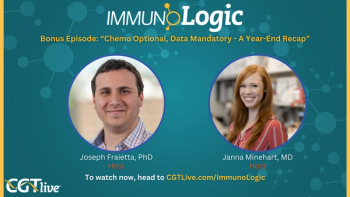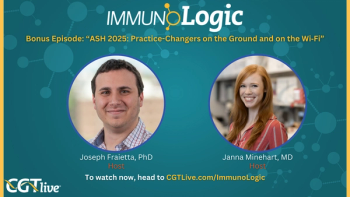
Novartis Drops Development of Geographic Atrophy Gene Therapy GT005
Novartis stated that the decision was made in light of a recommendation from an independent data monitoring committee.
Novartis has discontinued development of GT005 (PPY988), an investigational adeno-associated virus (AAV) vector-based gene therapy intended to treat geographic atrophy (GA) secondary to dry age-related macular degeneration (dry AMD), that was being evaluated in several clinical trials including the phase 2 EXPLORE study (NCT04437368).1
Novartis stated that the decision was made in light of a recommendation from an independent data monitoring committee (DMC) after an overall benefit risk assessment of the data from the clinical trials was carried out. Although no new safety signals were observed, it was determined that criteria for futility was met in the data. The company noted that long-term safety follow-up for the treated patients will continue.
“Our disappointment in this outcome is first and foremost for the GA community,” Novartis wrote in a press release.1 “We are subsequently communicating with study investigators, health authorities, and relevant bodies and are committed to sharing information from these early studies with the Ophthalmology and scientific communities to help inform future development of gene therapies. We sincerely thank the study participants and the investigators for their participation.”
In addition to EXPLORE, GT005 was being evaluated in the first-in-human phase 1/2 FOCUS clinical trial (NCT03846193), the phase 2 HORIZON clinical trial (NCT04566445), and a long-term follow-up study referred to as ORACLE (NCT05481827). EXPLORE, an outcomes assessor-masked, multicenter study, assessed a low dose treatment group and a high dose treatment group for GT005 against a control group. The study aimed to enroll 75 patients in total, with 25 patients to be randomly assigned to each of the 3 groups. Patients in the 2 treatment groups each received GT005 as a single dose, delivered via subretinal injection; patients in the control group did not receive GT005.
The study included patients with GA secondary to AMD in 1 eye (the study eye) and AMD in the contralateral eye who were 55 years of age or older. Participants were required to have a best-corrected visual acuity (BCVA) of at least 24 letters and a rare genetic variant of the CFI gene. GA lesions were required to be within an acceptable size on fundus autofluorescence (FAF) and to reside completely within the FAF image. No more than 25% of participants were allowed to have choroidal neovascularization (CNV) in the fellow eye and no participants could have CNV, or a history of CNV, in the study eye. Patients with axial myopia greater than -8 diopters in the study eye were excluded from participation. Additional inclusion and exclusion criteria existed, most of which related to patient health status and health history.
EXPLORE’s primary end point was the change from baseline at 48 weeks in GA area, measured by FAF. The change from baseline in GA area as measured by FAF at 72 weeks and 96 weeks was listed as a secondary end point. Additional secondary end points included the frequency of treatment-emergent adverse events and macular sensitivity as assessed by mesopic microperimetry at 96 weeks. Also serving as secondary end points were the changes at 96 weeks in retinal microstructures on optical coherence tomography (OCT); presence of area of nascent GA on OCT; GA morphology on multimodal imaging; macular sensitivity as assessed by mesopic microperimetry; BCVA Score via the early treatment for diabetic retinopathy (ETDRS) chart; low luminance difference via the ETDRS chart; reading performance as assessed by Minnesota low-vision reading test; functional reading independence index; and quality of life measured on the Visual Functioning Questionnaire-25.
Novartis originally obtained the GT005 program as part of its acquisition of Gyroscope Therapeutics in a deal announced in December 2021.2 The deal included an $800 million upfront payment from Novartis and potential for additional milestone payments. GT005 had previously been granted fast track designation by the FDA.
Several other companies are also developing advanced therapeutics for GA. Among these are
REFERENCES
1. GT005 (PPY988): Development program in geographic atrophy. News release. Novartis. September 11, 2023. Accessed September 12, 2023. https://www.novartis.com/news/gt005-ppy988-development-program-geographic-atrophy
2. Novartis to acquire Gyroscope Therapeutics, adding a one-time gene therapy that could transform care for geographic atrophy, a leading cause of blindness. News release. Novartis. December 22, 2021. Accessed September 12, 2023. https://www.novartis.com/news/media-releases/novartis-acquire-gyroscope-therapeutics-adding-one-time-gene-therapy-could-transform-care-geographic-atrophy-leading-cause-blindness
3. Lineage announces pipeline expansion to include auditory neuronal cell therapy for treatment of hearing loss. News release. Lineage Cell Therapeutics. March 21, 2022. Accessed September 12, 2023. https://www.businesswire.com/news/home/20220321005294/en/Lineage-Announces-Pipeline-Expansion-to-Include-Auditory-Neuronal-Cell-Therapy-for-Treatment-of-Hearing-Loss
Newsletter
Stay at the forefront of cutting-edge science with CGT—your direct line to expert insights, breakthrough data, and real-time coverage of the latest advancements in cell and gene therapy.





































